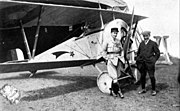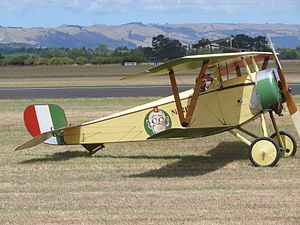| Nieuport 11 | |
|---|---|
| An Italian built Nieuport 11 | |
| Role | Fighter |
| Manufacturer | Nieuport |
| Designer | Gustave Delage |
| Introduction | 5 January 1916 |
| Retired | Summer of 1917 |
| Status | Used as a trainer until the end of the First World War[1] |
| Primary user | Aéronautique Militaire |
| Variants | Nieuport 17, 24bis., 27 |
The Nieuport 11, often nicknamed the Bébé, was a French World War I single seat fighter aircraft, designed by Gustave Delage.[2] It is famous as one of the aircraft that ended the 'Fokker Scourge' in 1916.[3]
Design and development[]
The Nieuport 11 was basically a smaller, neater version of the Nieuport 10 - designed specifically as a single-seat fighter. Like the "10" the "11" was a sesquiplane, a biplane with a full-sized top wing with two spars, and a lower wing of much narrower chord and just one spar. A "Vee" interplane strut joined the monospar lower wing with the broader upper wing on each side. The main drawback of this particular layout is that unless it is very strongly built, the narrow lower wing is prone to twist and bend under stress.[4] This was a problem with the higher powered "Vee-Strut" Nieuports, as well as the German Albatros D.III, V and Va, which adopted a generally similar wing design.[5]

Nieuport 11 C.1 in Belgian service
Nieuport 11s were supplied to the Aéronautique Militaire, the Royal Naval Air Service, the Dutch air service, Belgium, Russia and Italy. 646 were produced by the Italian Macchi company under licence.[1][5] Although its own operational career was short, it was the first in a line of single seat "Vee-Strut" Nieuport fighters - the most important being the Nieuport 17, 24bis. and 27.
Nieuport 16[]
In 1916 an improved version appeared as the Nieuport 16 which was a Nieuport 11 airframe powered by the 110 hp (92 kW) Le Rhône 9J rotary engine.[3] Visible differences included a larger aperture in front of the "horse shoe" cowling and, at least in some cases, a pilot headrest fairing.[5] Later versions had a deck-mounted synchronized Vickers gun, but in this configuration the combined effect of the heavier 9J engine and the heavier Vickers gun compromised maneuverability[5] and made the craft decidedly nose-heavy. The next variant, the slightly larger Nieuport 17 C1, was designed from the outset for the heavier engine, and remedied the 16's c.g. problems, as well as providing an improved performance.[6]
Operational history[]

A Nieuport 11 at the Auto & Technic museum Sinsheim
The type reached the French front in January 1916, and 90 were in service within the month. This small, lightly loaded sesquiplane outclassed the Fokker Eindecker in practically every respect. Among other features it had ailerons for lateral control rather than the obsolete wing warping of the Fokker - and its elevator was attached to a conventional tail plane as opposed to balanced "Morane type" elevators, making it much easier to fly accurately. The Fokker's success had largely been due to its synchronized machine gun which fired forward through the arc of its propeller. At the time, the Allies did not possess a similar system, and the Nieuport 11's Lewis or Hotchkiss machine gun, both designs having open bolt firing cycles unsuitable for synchronization, was mounted on the top wing to fire over the propeller, achieving similar results. There were however problems with clearing gun jams and replacing ammunition drums in flight, which were eventually solved in British service with the invention of the Foster mounting, and in French service by the adoption of the Alkan synchronization gear, which was applied to Nieuport fighters from the Nieuport 17 onwards.[6]
During the course of the Battle of Verdun in February 1916, the Nieuport 11 inflicted heavy losses on the enemy, forcing a radical change in German tactics.[1]
Some Nieuport 11s were modified in service to fire Le Prieur rockets from the struts. These weapons were intended for attacks on observation balloons and airships.[5]
By March 1916 the Bébé was being replaced by the improved Nieuport 17.[1] This type was in turn replaced by SPAD S.VII in most French squadrons early in 1917, and by the Royal Aircraft Factory S.E.5a in British squadrons later in the year.[1][5] Thereafter the Nieuport single seat types were widely used as trainers.[5]
Variants[]
- Nieuport 11
- Single-seat fighter-scout biplane. The type was also known as the Nieuport Scout and Nieuport Bebe.
- Nieuport 16
- Improved version. Single-seat fighter-scout biplane, powered by a 110 hp (92 kW) Le Rhone 9J rotary piston engine.
Operators[]
- Polish units in Imperial Russian Air Force
- Soviet Air Force - Taken over from the Imperial Russian Air Force.
- Royal Thai Air Force operated four aircraft.
- Ukrainian Air Force operated one aircraft only.
- Royal Flying Corps - Nieuport 16 only[7]
- Royal Naval Air Service
Specifications (Nie 11)[]

A Nieuport 11 with Belgian colors
Data from "The Worlds Greatest Aircraft"[3]
General characteristics
- Crew: one, pilot
- Length: 5.8 m (19 ft 0 in)
- Wingspan: 7.55 m (24 ft 9 in)
- Height: 2.4 m (7 ft 10.5 in)
- Wing area: 13 m² (140 ft²)
- Empty weight: 344 kg (759 lb)
- Loaded weight: 480 kg (1,058 lb)
- Max. takeoff weight: 550 kg (1,213 lb)
- Powerplant: 1 × Gnome Lambda seven-cylinder, or Le Rhone 9C nine-cylinder air-cooled rotary engine, 59.6 kW (80 hp)
Performance
- Maximum speed: 156 km/h (97 mph)
- Range: 330 km (205 miles)
- Service ceiling: 4,600 m (15,090 ft)
- Rate of climb: 15 mins to 3,000 m (9,840 ft)
- Power/mass: 1.49 kW/kg (0.09 hp/lb)
Armament
See also[]
References[]
| Wikimedia Commons has media related to Nieuport 11. |
- Notes
- Bibliography
- Angelucci, Enzio, ed. The Rand McNally Encyclopedia of Military Aircraft. New York: The Military Press, 1983. ISBN 0-517-41021-4.
- Bruce, J.M. The Aeroplanes of the Royal Flying Corps (Military Wing). London: Putnam, 1982. ISBN 0-370-30084-X.
- Chant, Christopher and Michael J.H. Taylor. The World's Greatest Aircraft. Edison, NJ: Cartwell Books Inc., 2007. ISBN 0-7858-2010-8.
- Cheesman E.F., ed. Fighter Aircraft of the 1914-1918 War. Letchworth, UK: Harleyford Publications, 1960. ISBN 978-0-8306-8350-5.
- Cooksley, Peter. Nieuport Fighters in Action. Carrollton, Texas: Squadron/Signal Publications, 1997. ISBN 0-89747-377-9.
- Fitzsimons, Bernard, ed. The Illustrated Encyclopedia of the 20th Century Weapons and Warfare. London: Purnell & Sons Ltd., 1967/1969. ISBN 0-8393-6175-0.
- Janić Č, Petrović O, Short History of Aviation in Serbia, Beograd, Aerokomunikacije, 2011. ISBN 978-86-913973-2-6
| ||||||||||||||
The original article can be found at Nieuport 11 and the edit history here.
